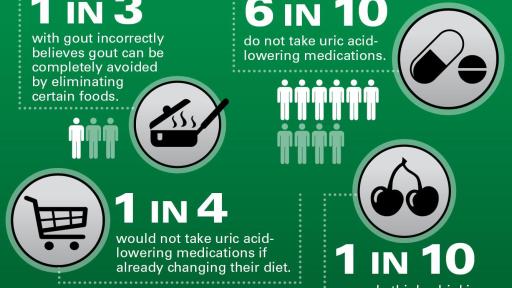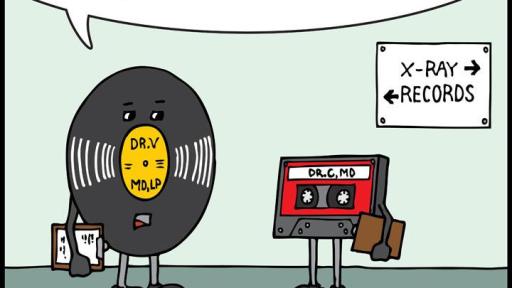Role of Diet Over-Prioritized in Gout Treatment
New Research from Gout & Uric Acid Education Society Reveals Many Incorrectly Think Gout Can Be Successfully Managed with Diet Changes Alone
PR Newswire, PITTSBURGH, May 19, 2016 A new survey from the Gout & Uric Acid Education Society (GUAES) finds many Americans with gout may be placing too much emphasis on diet when it comes to managing the disease and controlling painful flares. Of all the steps taken to manage gout, respondents cited changing their diet by eliminating or reducing consumption of certain foods as their top step taken (50 percent)—even ahead of taking medications to lower their uric acid levels (40 percent) and maintaining an overall healthy fitness level (33 percent). Furthermore, nearly one in three with gout incorrectly believes that the disease can be completely avoided by eliminating certain foods; and more than one in four said they would not take medications if they were making dietary changes.
“Physicians all too often see patients who believe they can successfully manage their gout with diet alone,” said N. Lawrence Edwards, M.D., a rheumatologist and GUAES chairman. “But even with extremely rigid diet restrictions, most gout patients will only be able to lower their uric acid levels slightly—not nearly enough to achieve a healthy level to control flares and reduce risk for long-term damage.”
Gout is an extremely painful and chronic form of inflammatory arthritis caused by elevated uric acid levels. Over time, uric acid can accumulate and form crystals in the joints and other tissues—leading to painful flares. Untreated, gout can lead to permanent bone, joint and tissue damage, and other serious health issues, including kidney disease, heart disease and diabetes.
In conjunction with Gout Awareness Day (May 22), GUAES is urging gout sufferers to learn more about the disease, seek immediate treatment and take ongoing steps to manage gout—with the most important step being to check uric acid levels regularly (every six months) and aim for a healthy target of 6 mg/dL or below. While uric acid-lowering medications are typically needed to control gout and reduce future risks, those with gout should also make lifestyle changes—which includes following a healthy and balanced diet.
The Role of Diet in Gout Management
There isn’t a regimented gout diet, but those with gout should make healthy food choices and may need to reduce consumption of certain foods. Because uric acid is formed from the breakdown of purines, foods high in purines—such as beer, red meat and shellfish—have been known to trigger gout flares. Foods containing high-fructose corn syrup—including soft drinks, sweetened juices, pastries and processed foods—should also be avoided or eaten in moderation. Those with gout are instead encouraged to eat fresh fruit and vegetables, low- or no-fat dairy products and nuts and grains.
New research from @GoutEducation reveals many incorrectly think #gout can be managed with #diet changes alone. #GoForSix Tweet
While cherry juice is often in the news as a potential treatment of gout, Dr. Edwards urges gout patients to take steps beyond adding this to their diet.
“The role of cherry juice in gout management is overstated,” said Dr. Edwards. “While Vitamin C—which is found in cherry juice or cherries—can play a role in lowering uric acid levels, consuming cherry juice alone is not going to be enough. Additionally, if patients are drinking cherry juice that is sweetened with high-fructose corn syrup, that can even contribute to or worsen a flare.”
The GUAES survey found that nearly one in six gout patients (16%) believes that drinking cherry juice is just as effective as taking uric acid-lowering medications.
“In symptomatic gout, it’s not,” added Dr. Edwards. “Those with gout need to monitor their uric acid levels closely, and work with their physician to determine an appropriate treatment plan to keep levels to 6 mg/dL or even below, depending on the stage of the disease and severity of symptoms.”
For additional information and resources about gout and diet, and other topics, visit GoutEducation.org.
About GUAES
The Gout & Uric Acid Education Society is a nonprofit organization of health care professionals dedicated to educating the public and health care community about gout—the most common form of inflammatory arthritis—and the related consequences of hyperuricemia. Learn more at gouteducation.org. Twitter: @GoutEducation Facebook: Gout Education
# # #
Online survey of 1,000 nationally representative Americans ages 18+, with an oversampling of 103 interviews of adults who have been diagnosed with gout. Conducted April 11-18, 2016 by Wakefield Research on behalf of the Gout & Uric Acid Education Society.
Media Contacts:
Ellen Dietrick
[email protected]
412-862-1915
Melissa Rieger
[email protected]
412-251-2172







